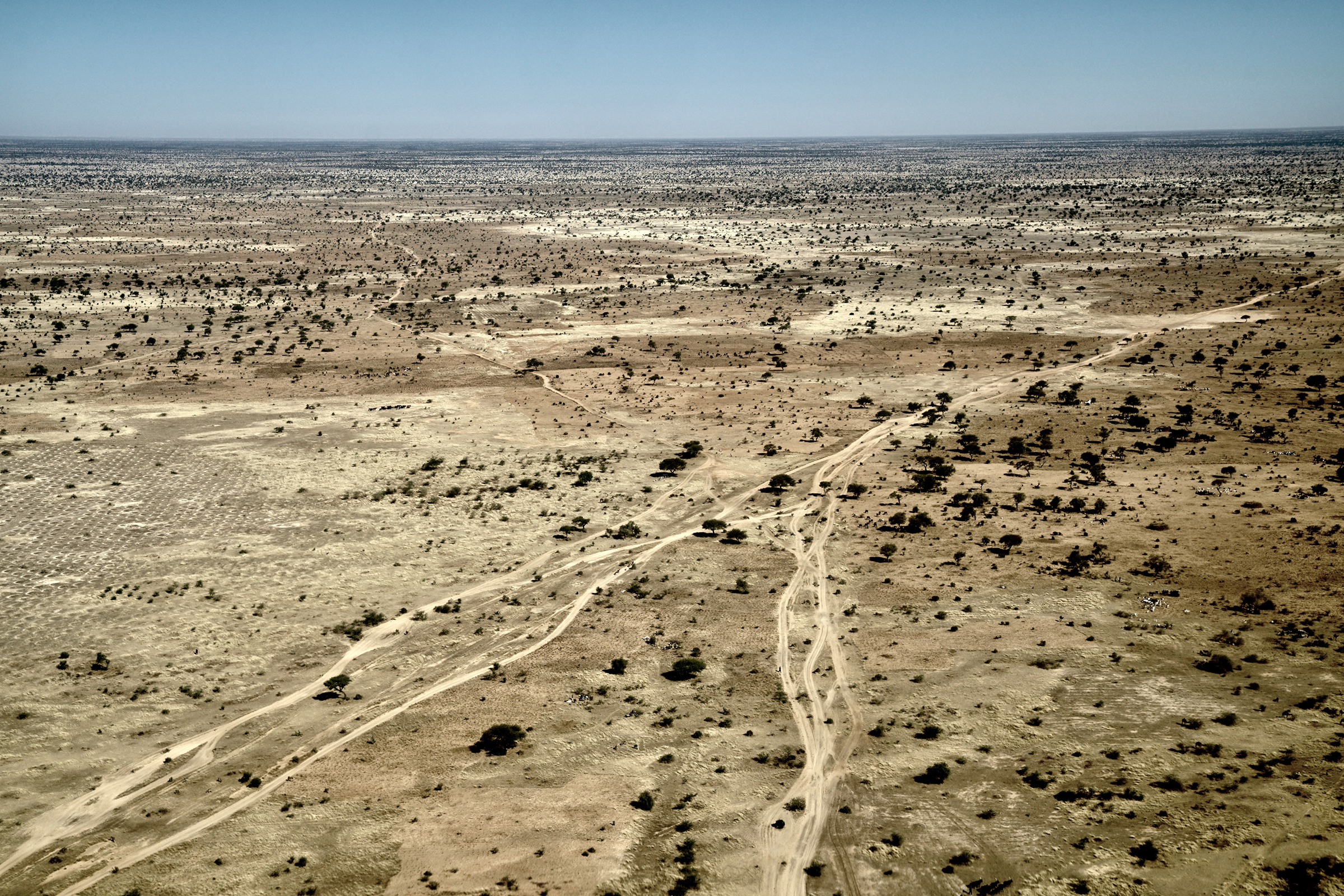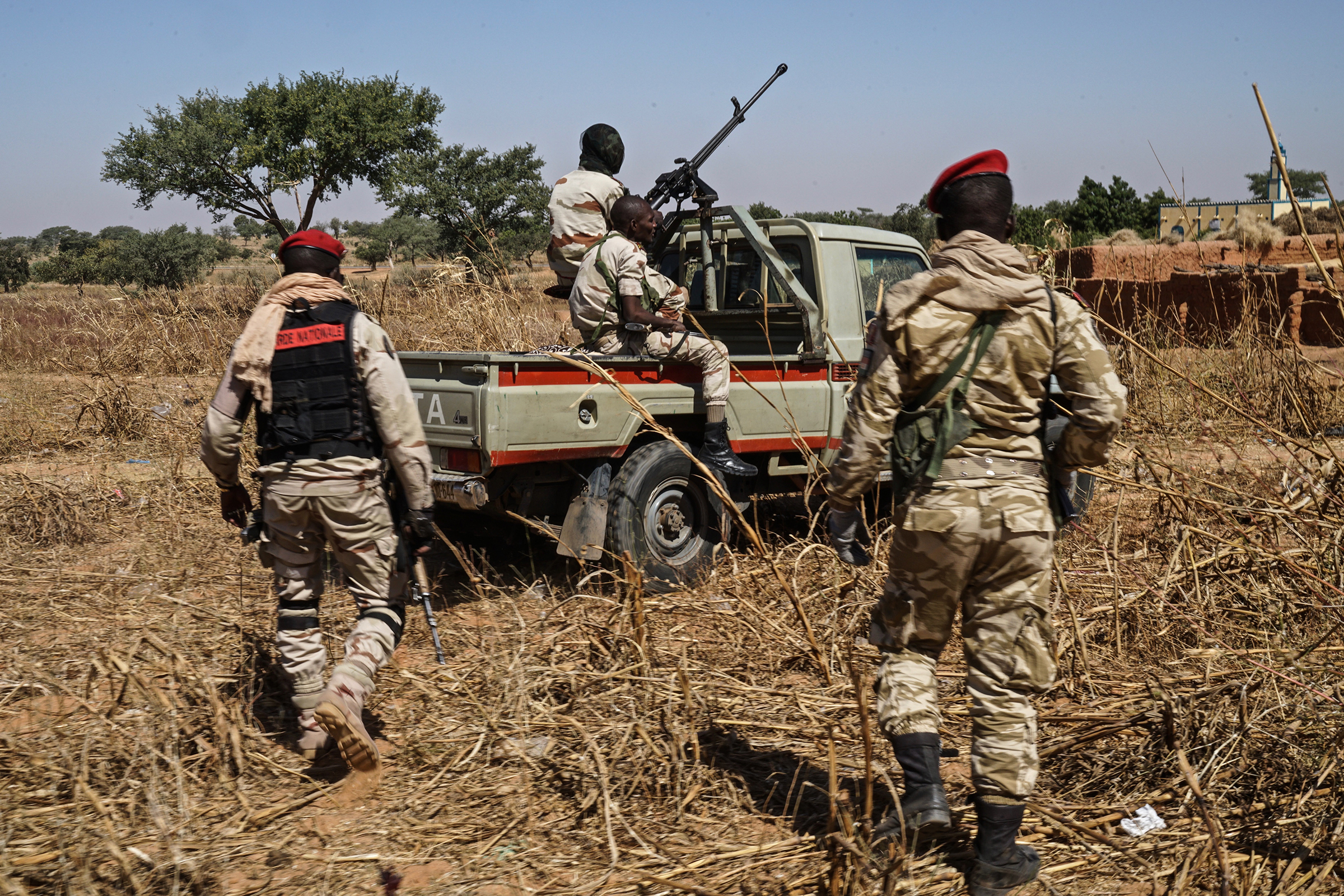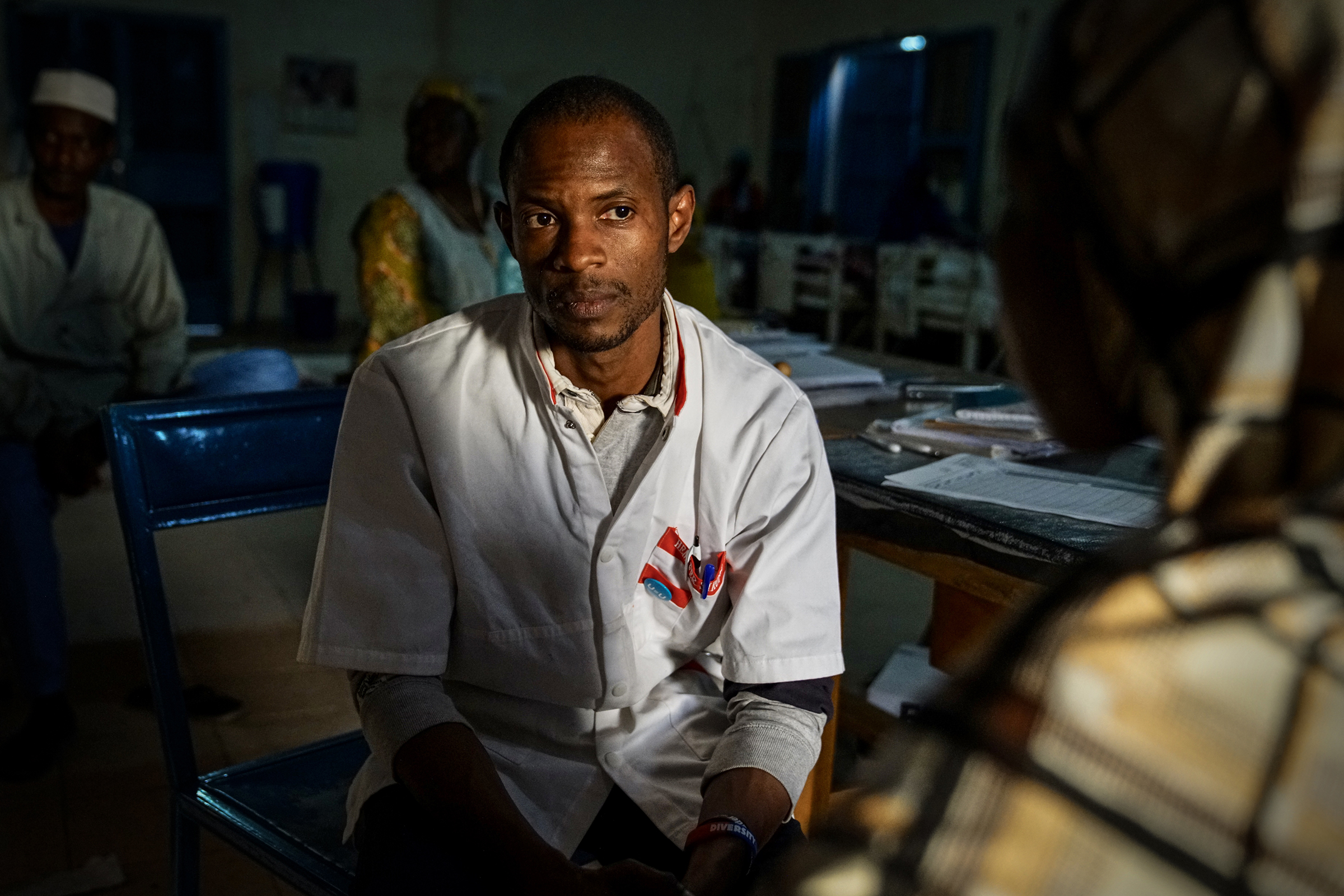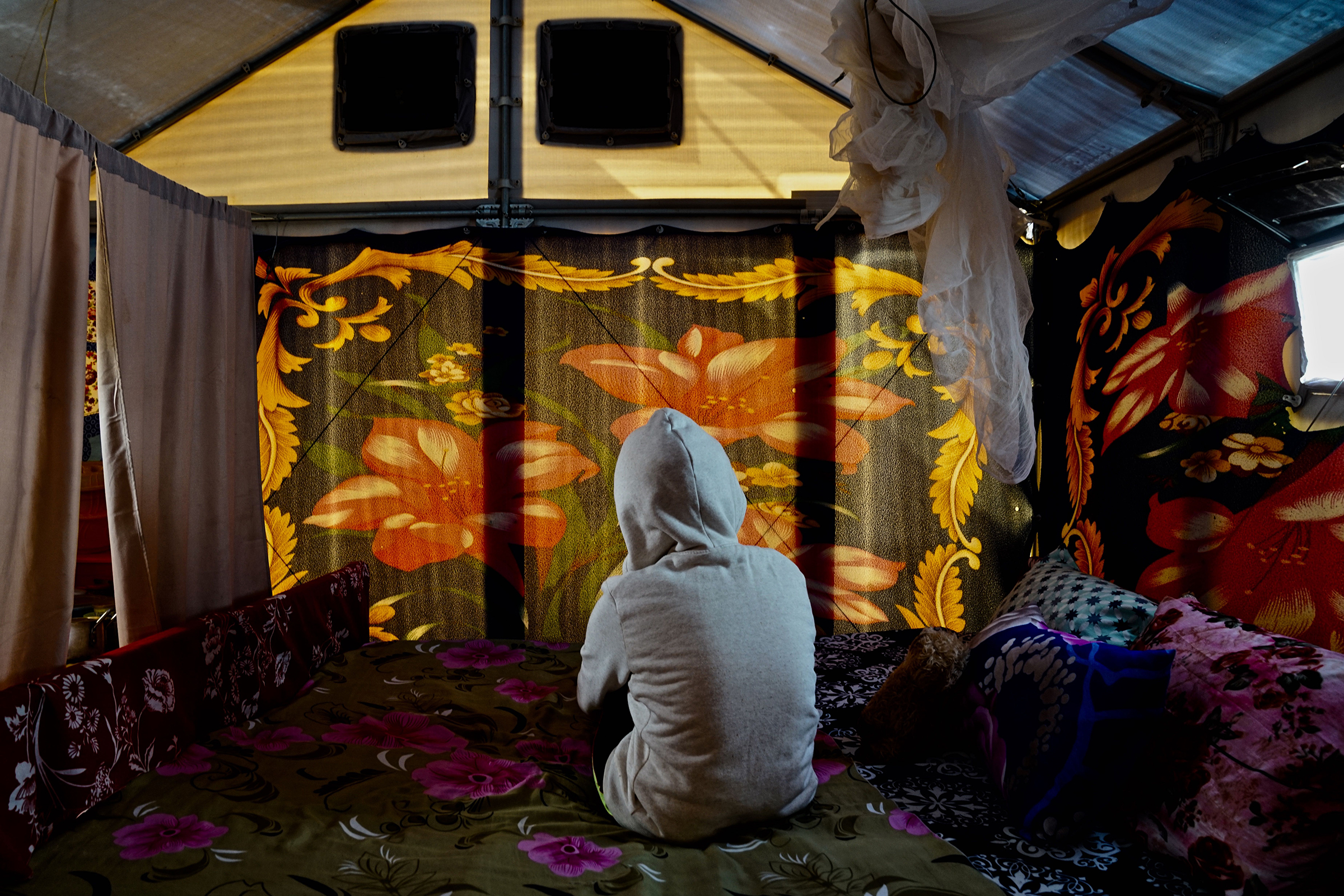
The gunshots began in the middle of the night late in 2018. Ali Bakara, a twenty-eight-year old mother of eight, was jolted awake. It was three o’clock in the morning in her village near Maiduguri, in northern Nigeria. “They kept shooting until nine o’clock,” she remembered. When it was finally safe to leave the house, Ali and her family saw smoldering homes, burned by militants.
Her home state of Borno had long suffered from Islamist violence at the hands of Boko Haram and its offshoots, including the Islamic State’s West Africa Province, or ISWAP, which split from Boko Haram a decade ago. The militant groups routinely massacre, torture and rape civilians as they seek to control areas of land and govern them as independent entities that hew to their extreme interpretations of Islam. More than 30,000 people have been killed in the decades-long insurgency. In mid-December, four kidnapped aid workers for the group Action Against Hunger were executed by ISWAP in the border city of Damasak.
Ali’s husband, Issa, a driver, decided that they should leave Maiduguri with their children. “The next night, we left silently, on foot.” They fled north like many before them, toward Niger, the country that borders Nigeria to the north. At the town of Damasak, they were able to climb aboard a pickup heading toward Niger, but one of their children fell from the vehicle and died. Now they have spent a year waiting in a refugee camp in Niger with little to do. “We’re just sitting here, hoping for some kind of way to make a living,” Ali told me. “We can never go home.”
I traveled to Niger in December with the United Nations’ Assistant Secretary General for Humanitarian Affairs, Ursula Mueller, who was in the country to review U.N. humanitarian programs and build relationships with the Nigerien authorities. The country hosts almost half a million refugees, despite the fact it ranks last on the U.N.’s human development index, which ranks countries on per capita income, life expectancy and levels of education. Hundreds of thousands of migrants have traversed its deserts seeking a better life in Europe over the last decade—in just five months, from February to June, 2016, the International Organization for Migration recorded more than 168,000 migrants heading north out of two of Niger’s Saharan transit towns.
Now Niger itself is reaching a crisis point. A series of Islamist insurgencies, linked to groups like ISIS and al-Qaeda, has boiled across the country for the past five years. In the last few months, jihadi assaults have intensified. The Armed Conflict Location & Event Data Project, a non-profit that monitors violence globally, said that the number of attacks had doubled in the country in the last year.
In the last two months, Niger has suffered two of the worst assaults on its military forces in living memory. In December, while I was in the country, ISWAP assaulted a military base at In Atès, killing 71 Nigerien soldiers. On January 9, at least 89 soldiers were killed in an assault at Chinagodrar, in the country’s west, and France’s air force had to scramble to ward off the attackers. (ISWAP later claimed responsibility.) In the aftermath, Niger’s president fired the head of the army. At a Jan. 13 summit in France, Sahelian countries pledged to reinforce security cooperation, and French President Emmanuel Macron promised to send 220 more French troops to the region.
***

I met Bakara at a refugee settlement in the southeastern Diffa region of Niger. The Diffa region alone hosts 260,000 refugees and displaced persons. Mud-brick houses, homes fashioned of bundled wood and temporary shelters stretch into the distance. As we spoke, two boys flew a kite made from the scraps of a garbage bag, hovering like a black spirit in the bright blue sky. Women collected water from a well and carried it back to their homes atop their heads in metal basins painted with the slogan “Unity and Faith,” and then underneath, “Nigeria.”
Awaridi, as the refugee settlement is called, crouches on a vast, flat plain of dust. Here, some 9,000 refugees and displaced people have built temporary lives. Some have lived there as long as five years now, waiting for something to improve. Many of the camp’s 5,000 or so internally displaced have fled Niger’s worst flooding in a hundred years. As climate change intensifies, weather patterns in this part of the world swing between ever-widening extremes of drought and intense heat. Across the country, 19,000 homes have been destroyed and almost a quarter of a million people affected. Around Diffa, the flooding has filled undulations of dry shrubscape into surreal, glistening pools of water, boiling in the West African sun.
Awaridi is not an official refugee camp, and the residents say the conditions are difficult, despite help from U.N. agencies, which helped provide water and other services for the settlement, and international humanitarian organizations who have provided latrines and cash distributions. “We have nothing here, nothing,” said Souley Gueré, a herder who fled Boko Haram violence in Niger’s easterly province of Bosso, on the shores of Lake Chad. “When we want to eat, our wives go in the town and do small jobs, pounding millet or washing clothes, and then come back with food. We have no proper houses, no food, nothing at all.”
“For eight months there has been no food,” Aboucar Malam Madou, a flinty 59-year-old farmer, told me. He explained that he had fled the town of Abadam, which straddles Niger’s thinly policed border with Nigeria, when Islamists attacked it six years ago. “I saw them shooting soldiers and burning their cars.”
He left his 20 cattle and bounced from town to town until he arrived in Awaridi. He has now been in the camp since April. “If we have food and then places on which we can farm, then we will have solutions to all of those other problems.”
***

Niger sits at the center of the Sahel, the vast dry shore of scrubland that separates the plains and jungles of Central Africa from the dune seas of the Sahara Desert. In recent years, a tide of weapons and violence has swept through the region, exacerbated by extremist interpretations of Islam, unresolved rivalries between different communities and ethnic groups, and the dividends that the smuggling of sub-Saharan Africans north to Europe has brought to criminal and armed groups.
The assault at In-Atès, in northwestern Niger, happened shortly after I met Bakara at Awaridi. News soon filtered through that ISWAP had claimed the attack. The militants used a drone, hovering over the base, to target a mortar attack and hit a fuel tank during evening prayers. “ISWAP has been using commercial drones for observation for some time,” said Vincent Foucher, an expert on Boko Haram at the French National Centre for Science Research, saying that it mirrored attacks in Northern Nigeria. The militants had surrounded the base, and in the confusion that followed, began massacring the soldiers. Niger’s president, Mahamadou Issoufou, cut short an official visit to Egypt, and a meeting involving France and other countries in the region was postponed.
An international security source in the capital, who was not authorized to speak on the record, told me the soldiers had been based in an “indefensible” position, with a low wall around the base providing little protection from the militants. “Thirteen local leaders have been killed this year; we know exactly what the rebels are trying to do,” the source said. “Firstly, they are making the whole area inhospitable by carrying out these attacks, and then they step in to provide essential services. They want people to say that the government is doing nothing for us, and that the jihadists are more effective.”
The violence is exacerbating the problems of poverty in a region that can ill afford it. In Burkina Faso, Mali and Niger, some 2,000 schools have been closed since 2017 due to the ongoing violence. Niger, despite consistently ranking as one of the world’s poorest countries, spends a large portion of its small budget—2.5 percent of GDP—on its military. “That leaves not that much for education, for agricultural activities, for the health sector,” Mueller said.
***
Despite the huge problems it faces, the country is often seen as the calm eye of the Sahelian storm. “The country has a stable government for the moment that has often been willing to partner with international actors on humanitarian projects,” the U.N.’s Mueller told me. She told me that aid to humanitarian causes in Niger is considered incredibly cost-effective: not only do such funds help to address current issues, they also serve to mitigate the effects of the continued effects of climate change and insecurity. She urged donor governments to do more before it was too late.
“If one neighbor after the next is going down, we can already anticipate what’s happening in this country,” she said. “And when you look across the Sahel, I think there’s a huge opportunity now to step up all kinds of assistance the international community can provide to the government and the people of Niger.” Mueller pointed out that it was not just humanitarian assistance that was needed, but development projects to bring hope and jobs to the young people of Niger.
To see the crises like the one that caused Bakara to flee from Nigeria and the assault on the military base at In-Atès as inextricably connected is perhaps reductive—they, are, after all, separated by 800 or so miles—but both illustrate the precarious situation in Niger. The country faces elections later this year, and in many ways feels as if it is at the edge of a precipice. The hotels in Niamey, the capital, buzz with foreign military personnel and intelligence officers trading glances over beers. The U.S. is building a $110 million drone base near Agadez, in the country’s north. In the east, the country is fighting a bitter war against Boko Haram on the shores of Lake Chad; in the south, the country is seeing large numbers of Nigerians fleeing north from heavily armed bandits who often follow them across the border; jihadi groups from Mali and Burkina Faso often spill into the country’s west; and the conflict in Libya continues to destabilize the north.
Climate change has exacerbated these conflicts, making farmland more and more scarce and adding to food insecurity as unpredictable climate events, like the recent flooding, become more common. In Niger, in 2018 alone, desertification claimed the equivalent of 150,000 football pitches.
In the Lake Chad region, to the East and Southeast of Diffa, the recent weather has affected local commerce, and added to the agricultural woes. “High levels of rainfall and wide temperature variability are undermining people’s lives and livelihoods,” a team of researchers wrote in “Shoring up Stability,” a recent report about Lake Chad by Adelphi, an independent think tank that focuses on climate, security and international affairs. The flooding in the last few months has squeezed militant groups who have increased raiding and kidnapping. “The lake is very high this year so it has destroyed a potential part of the crops that they had planted,” Foucher, the expert on Boko Haram, told me. He pointed out that local leaders have responded by increasing raiding and kidnapping for ransom. “These days ISWAP seems to have fewer vehicles, less fuel, fewer resources; this makes plain why some ISWAP groups engage in kidnappings and plunder.” The militants also seem to be worried about food shortages: the group recently lifted a price cap on maize and beans to incentivize production, and forbade export of the crops. “They have a food problem,” Foucher continued. “They know it and they are trying to modify their policies.”
Laouan Magagi, the Nigerien minister for humanitarian affairs and disaster management told me that the cross-border movement, paired with the drying out of the land and the recent flooding, were all contributing to the country’s woes. “It’s a paradox: flooding and then there have been a lot of zones where, practically, the pastures are bare,” Magagi said. “There are lots of regions where farmers have sown seeds many times and have harvested nothing.” Temperatures in the region are rising at one-and-a-half times the global average.
“It’s climate change. In Niger, even the peasant in the fields knows that this is global warming, because they live this day to day,” Magagi said. “The Sahel is not a polluter, absolutely not,” he insisted. According to data from the European Union’s emissions database, Mali, Mauritania, Niger, Burkina Faso and Chad—the countries that are part of the G5 Sahel framework, which deals with issues affecting the region—produced a little more than 10 million metric tonnes of carbon dioxide in 2016. The United States produced around 5 billion metric tonnes of the gas in the same year. What’s more, a team of French researchers showed that some Sahelian pastoral practices have a negative carbon balance. “The polluting countries are not sufficiently engaged,” Magagi added, “the polluters should pay their fair share. If they pay sufficiently in our region, the people who work the land will be able to increase their resilience.”
***

Demographics are also key to understanding the crisis affecting the Sahel. Almost half of Niger’s population is under the age of 15. The region’s population is young, but hungry and without opportunities. In the central Nigerien town of Maradi, the country’s old economic hub, I visited the Integrated Nutritional Rehabilitation Center at the town’s Regional Hospital. Niger’s population is exploding, and is set to double over the next 20 years. Women here have on average more than seven children, the highest fertility rate in the world. Raising those children is very difficult . “Because of climate change the price of food is now very expensive,” Kadri Suleiman, the head of the hospital, told me. “Malnutrition is a big problem here.”
In the ward, around two dozen women clustered on white-frame metal beds, nursing frail children with matchstick arms. Half the lights in the room had failed, lending it a spectral gloom. Baraka Samaila, a 35-year old tradeswoman wearing a beige-checked veil, told me how she had married at 13, and how each of her seven children had suffered from malnutrition. Her 2-year-old son Issoufa lay beside her, withered and moving as if in slow motion. Another woman, Marwa Sané, a 27-year old mother of two, said her child had begun vomiting and was suffering from malaria. She had to journey three hours in order to get to the clinic.
Suleiman told me that the conditions at the clinic had improved in the last five years, but the facility still saw a 5% death rate. The problems of malnutrition were often compounded by malaria and pneumonia. According to a report by USAID from 2018, 1.8 million children in Niger suffer from malnutrition, and one in 10 children suffer from acute malnutrition, which leads to cognitive impairment and sometimes death. When I returned the next day, one of the children I had seen the evening before had died.
It is remarkable, with conditions like these, that Niger has not slipped into the outright chaos, conflict and lawlessness that many of its neighbors face face. “There’s something rather special in Niger,” Foucher told me. Since elections in 2011, the government has been much more respectful of democratic norms than many of the governments in the region, and the country’s leadership is not mired in the same allegations of corruption and excess of some of its neighbors. Niger’s ruling class is also more diverse than those of its neighbors; the ethnic and tribal resentments that have fueled Islamist advances in countries such as Mali and Burkina Faso are less apparent. This diversity of backgrounds, and a tradition of dialoguing with local populations has led to a more collaborative approach to problem-solving on the Nigerien government’s behalf. “They have this capacity to negotiate conflict and work out compromises,” Foucher continued. “They know they are fragile, and they are being very careful and measured in their responses to things.”
One compromise the government has been able to make is offering amnesty to militants, among them many young people who joined the groups under threat of execution. I visited a center run by an U.N. agency that houses children who have renounced their ties with radical groups and prepares them for reintegration in society through psychosocial support.

The center admits young men and boys who joined the group as children, lodging them in a small house with a leafy courtyard. When I visited, the 19 teenagers there played table football, showed me how they had learned to sew and ate food in a common room furnished with a bookshelf laden with French comic books (Boule et Bill, Asterix). On the wall, a whiteboard listed their activities for the week (sewing, hip hop, theater). During a conversation with Mueller in the courtyard, a slender boy wearing a black T-shirt and blue trousers said that being at the center had given him the desire to work. (I was asked to withhold the names and information of the boys in the center for their security). “I have spent three months learning a trade and I hope I will be able to continue the work that I have learned here in the outside world,” he said.
Later, I spoke with Yunusa (not his real name), who wore a white tank top and a whisper of a mustache on his top lip. He had just turned eighteen. “I grew up in Nigeria. About three years ago soldiers withdrew from my village and Boko Haram had taken it,” he told me “Some people fled. Boko Haram said that if you ran away, they would kill you. The members of the group said that the villagers had three days. If they didn’t come and join their group, they would kill them and cut their brains out. So at that time I decided to join the group with my friends, and we left with them.”
Over the next two years, Yunusa told me, he was tasked with ferrying food from villages to the group’s child fighters and women. “It was like normal life, but there were very strict rules,” he said. “Even if you wanted to do something, there were rules and it was forbidden to do many things.” In 2018, he decided to repent and leave the group, after he heard about the amnesty; he was taken to a center for Boko Haram returnees at Goudoumaria, a town near Diffa, and then on to the center in which we were sitting. Now he has learned to sew and wants to continue to work when he leaves the center. “I was lucky to have the chance to understand that Boko Haram is not a good thing,” he said. “I hope that all young people, my family, and others understand that Boko Haram is not a good thing, and I hope it’s known all over the world.”
Niarchos is a writer based in New York. His work has appeared in The New Yorker and other magazines and newspapers. He is currently working on a book about the global cobalt trade.
More Must-Reads from TIME
- Why Biden Dropped Out
- Ukraine’s Plan to Survive Trump
- The Rise of a New Kind of Parenting Guru
- The Chaos and Commotion of the RNC in Photos
- Why We All Have a Stake in Twisters’ Success
- 8 Eating Habits That Actually Improve Your Sleep
- Welcome to the Noah Lyles Olympics
- Get Our Paris Olympics Newsletter in Your Inbox
Contact us at letters@time.com